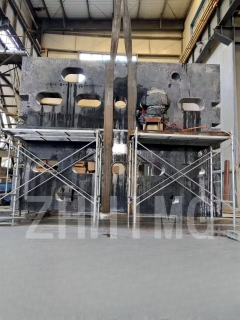Granite components have been widely used in the semiconductor manufacturing process due to their excellent characteristics such as superior surface finish, high stiffness, and excellent vibration damping. Granite components are essential for semiconductor fabrication equipment, including lithography machines, polishing machines, and metrology systems as they provide precision positioning and stability during the manufacturing process. Despite all the advantages of using granite components, they also have defects. In this article, we will discuss the defects of granite components for semiconductor manufacturing process products.
First, granite components have a high thermal expansion coefficient. It means that they expand significantly under thermal stress, which could cause issues during the manufacturing process. The semiconductor manufacturing process requires high precision and dimensional accuracy that could be compromised due to thermal stress. For instance, silicon wafer deformation due to thermal expansion could cause alignment issues during lithography, which could compromise the quality of the semiconductor device.
Second, granite components have porosity defects that could cause vacuum leaks in the semiconductor manufacturing process. The presence of air or any other gas in the system could cause contamination on the wafer's surface, resulting in defects that could affect the semiconductor device's performance. Inert gases such as argon and helium could seep into porous granite components and create gas bubbles that could interfere with the vacuum process's integrity.
Third, granite components have microfractures that could interfere with the manufacturing process's precision. Granite is a brittle material that could develop microfractures over time, especially when exposed to constant stress cycles. The presence of microfractures could lead to dimensional instability, causing significant issues during the manufacturing process, such as lithography alignment or wafer polishing.
Fourth, granite components have limited flexibility. The semiconductor manufacturing process requires flexible equipment that could accommodate different process changes. However, granite components are rigid and cannot adapt to different process changes. Therefore, any changes in the manufacturing process necessitate the removal or replacement of the granite components, leading to downtime and affecting productivity.
Fifth, granite components require special handling and transportation due to their weight and fragility. Granite is a dense and heavy material that requires specialized handling equipment such as cranes and lifters. Additionally, granite components require careful packing and transportation to prevent damage during shipment, leading to additional costs and time.
In conclusion, granite components have some drawbacks that could affect semiconductor manufacturing process products' quality and productivity. These defects could be minimized through careful handling and maintenance of granite components, including periodic inspection for microfractures and porosity defects, proper cleaning to prevent contamination, and careful handling during transportation. Despite the defects, granite components remain a vital part of the semiconductor manufacturing process due to their superior surface finish, high stiffness, and excellent vibration damping.
Post time: Dec-05-2023

